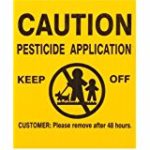Notice the yellow warning signs placed on a lawn after a professional lawn care treatment.
Ask your lawn care provider for a list of all chemicals put on your lawn during the entire year. Look the chemicals up on the Internet searching for effects on children and pets.
The commonly used lawn herbicides like 2-4-D and 2-4-5-T are essentially plant-growth hormones. They cause the plant to “grow itself to death.” That is why you see the dandelions turn upside down after being sprayed with 2-4-D or other similar chemicals. 2-4-D is one of the two main chemicals used in Agent Orange in Vietnam. Pets, children, and adults exposing bare skin (feet or hands) to lawns treated with chemicals risk dangerous side effects.
A professional dog trainer said that many people attribute cancer in dogs to  exposure to lawn care chemicals. Your dog or cat could walk through lawn care chemicals and later lick its feet. The chemicals can be absorbed through the skin and be tracked into the house from a treated lawn. While treating lawns, the chemicals can be inadvertently sprayed onto sidewalks or relocated by rain. The fumes are also dangerous.
exposure to lawn care chemicals. Your dog or cat could walk through lawn care chemicals and later lick its feet. The chemicals can be absorbed through the skin and be tracked into the house from a treated lawn. While treating lawns, the chemicals can be inadvertently sprayed onto sidewalks or relocated by rain. The fumes are also dangerous.
Here are just a few of the many links on the subject.
- http://www.petmd.com/dog/care/dangers-lawn-chemicals-your-perfect-lawn-killing-your-pet
- http://www.pesticidewatch.org/sites/default/files/pets_guide_draft_final.pdf
- http://blogs.uwhealth.org/kids/2012/06/lawn-chemicals-and-kids-should-parents-be-concerned/
- http://npic.orst.edu/health/child.html
Please help to make everyone aware of the potential dangers of lawn care chemicals and to take appropriate action to protect children and pets.
A word about lawn weeds.
The weeds are green are they not? They can also contribute to food for birds, rabbits, bees, etc. I like the dandelions yellow flowers and call them “Spring Mums”, they mostly bloom only for a few weeks in the spring. If you don’t like the dandelion flowers then just mow them. Clover not only produces food for wildlife, but the flowers also give a pleasant scent. Clover adds nitrogen to the soil that helps the grass thrive. In the past, clover seed was sometimes added to commercial grass seed. Other weeds have beneficial properties. Do we really need a perfect weed-free lawn?
How can I maintain a reasonably attractive lawn without using chemicals?
Healthy grass will tend to choke out or at least reduce the number of most weeds. In this part of the country, the soil is very likely to be acidic and most grass species do well in acidic soil. I apply a light dose of lime and lawn fertilizer every two or three years using a handheld spreader. Of course, increased fertilizing will probably result in increased mowing frequency. Keep the height of cut at least 2 ½ inches to give the grass a better chance to “smother” the weeds by reducing the sunlight going to the weeds. Watering in dry weather is good but there is no need to overdo it. Grass develops a very fibrous root system that also helps choke out the weeds.
Why are you bagging the lawn clippings?
I have never been able to understand why some people insist on bagging their lawn clippings. It makes more work and creates yard waste that requires some kind of disposal. Set your mower on “Mulch” and try to cut when the grass is dry. Wet grass does not mulch very well but sometimes it is required. The clippings (if any) from the previous mowing will be mulched when dry weather slows the growth and helps with mulching. Mulching reduces the need for fertilizer and is recommended by the county to reduce yard waste.
Arthur Osland has a B.S. in Horticulture Turf Management and ten years’ experience as a Golf Course Superintendent (Greens Keeper) before entering the IT industry.
